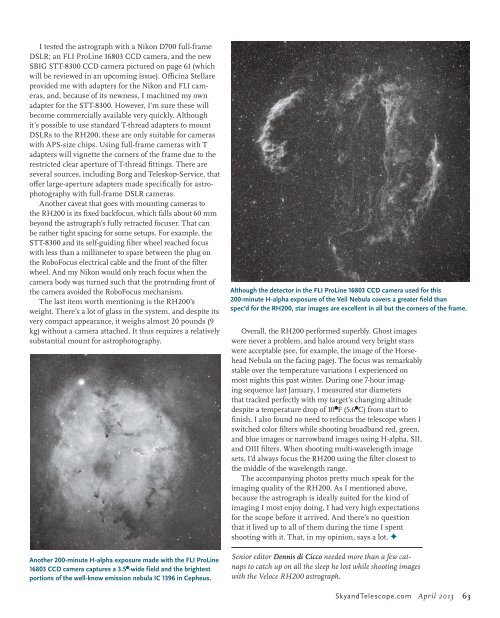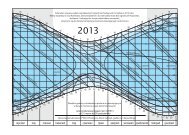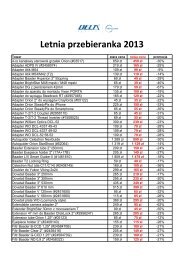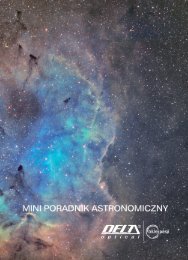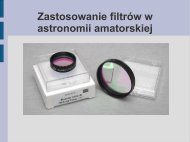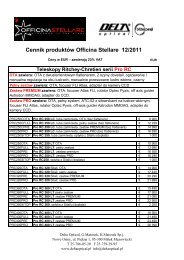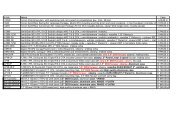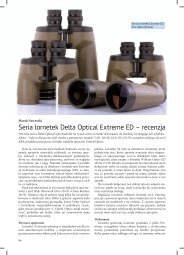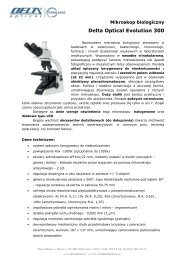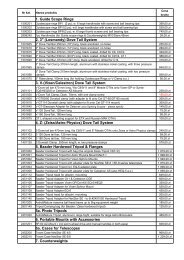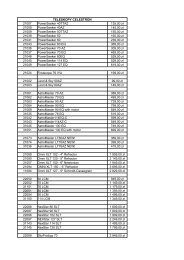Officina Stellare's Veloce RH200 Astrograph - Teleskop-Express
Officina Stellare's Veloce RH200 Astrograph - Teleskop-Express
Officina Stellare's Veloce RH200 Astrograph - Teleskop-Express
You also want an ePaper? Increase the reach of your titles
YUMPU automatically turns print PDFs into web optimized ePapers that Google loves.
I tested the astrograph with a Nikon D700 full-frame<br />
DSLR; an FLI ProLine 16803 CCD camera, and the new<br />
SBIG STT-8300 CCD camera pictured on page 61 (which<br />
will be reviewed in an upcoming issue). <strong>Officina</strong> Stellare<br />
provided me with adapters for the Nikon and FLI cameras,<br />
and, because of its newness, I machined my own<br />
adapter for the STT-8300. However, I’m sure these will<br />
become commercially available very quickly. Although<br />
it’s possible to use standard T-thread adapters to mount<br />
DSLRs to the <strong>RH200</strong>, these are only suitable for cameras<br />
with APS-size chips. Using full-frame cameras with T<br />
adapters will vignette the corners of the frame due to the<br />
restricted clear aperture of T-thread fittings. There are<br />
several sources, including Borg and <strong>Teleskop</strong>-Service, that<br />
offer large-aperture adapters made specifically for astrophotography<br />
with full-frame DSLR cameras.<br />
Another caveat that goes with mounting cameras to<br />
the <strong>RH200</strong> is its fixed backfocus, which falls about 60 mm<br />
beyond the astrograph’s fully retracted focuser. That can<br />
be rather tight spacing for some setups. For example, the<br />
STT-8300 and its self-guiding filter wheel reached focus<br />
with less than a millimeter to spare between the plug on<br />
the RoboFocus electrical cable and the front of the filter<br />
wheel. And my Nikon would only reach focus when the<br />
camera body was turned such that the protruding front of<br />
the camera avoided the RoboFocus mechanism.<br />
The last item worth mentioning is the <strong>RH200</strong>’s<br />
weight. There’s a lot of glass in the system, and despite its<br />
very compact appearance, it weighs almost 20 pounds (9<br />
kg) without a camera attached. It thus requires a relatively<br />
substantial mount for astrophotography.<br />
Another 200-minute H-alpha exposure made with the FLI ProLine<br />
16803 CCD camera captures a 3.5°-wide field and the brightest<br />
portions of the well-know emission nebula IC 1396 in Cepheus.<br />
Although the detector in the FLI ProLine 16803 CCD camera used for this<br />
200-minute H-alpha exposure of the Veil Nebula covers a greater field than<br />
spec’d for the <strong>RH200</strong>, star images are excellent in all but the corners of the frame.<br />
Overall, the <strong>RH200</strong> performed superbly. Ghost images<br />
were never a problem, and halos around very bright stars<br />
were acceptable (see, for example, the image of the Horsehead<br />
Nebula on the facing page). The focus was remarkably<br />
stable over the temperature variations I experienced on<br />
most nights this past winter. During one 7-hour imaging<br />
sequence last January, I measured star diameters<br />
that tracked perfectly with my target’s changing altitude<br />
despite a temperature drop of 10°F (5.6°C) from start to<br />
finish. I also found no need to refocus the telescope when I<br />
switched color filters while shooting broadband red, green,<br />
and blue images or narrowband images using H-alpha, SII,<br />
and OIII filters. When shooting multi-wavelength image<br />
sets, I’d always focus the <strong>RH200</strong> using the filter closest to<br />
the middle of the wavelength range.<br />
The accompanying photos pretty much speak for the<br />
imaging quality of the <strong>RH200</strong>. As I mentioned above,<br />
because the astrograph is ideally suited for the kind of<br />
imaging I most enjoy doing, I had very high expectations<br />
for the scope before it arrived. And there’s no question<br />
that it lived up to all of them during the time I spent<br />
shooting with it. That, in my opinion, says a lot. ✦<br />
Senior editor Dennis di Cicco needed more than a few catnaps<br />
to catch up on all the sleep he lost while shooting images<br />
with the <strong>Veloce</strong> <strong>RH200</strong> astrograph.<br />
SkyandTelescope.com April 2013 63


